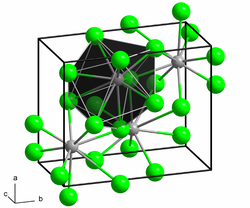Europium (II) chloride
| Crystal structure | |||||||||||||||||||
|---|---|---|---|---|---|---|---|---|---|---|---|---|---|---|---|---|---|---|---|

|
|||||||||||||||||||
| __ Eu 2+ __ Cl - | |||||||||||||||||||
| General | |||||||||||||||||||
| Surname | Europium (II) chloride | ||||||||||||||||||
| other names |
Europium dichloride |
||||||||||||||||||
| Ratio formula | EuCl 2 | ||||||||||||||||||
| Brief description |
white to pale pink solid |
||||||||||||||||||
| External identifiers / databases | |||||||||||||||||||
|
|||||||||||||||||||
| properties | |||||||||||||||||||
| Molar mass | 222.87 g mol −1 | ||||||||||||||||||
| Physical state |
firmly |
||||||||||||||||||
| density |
4.86 g cm −3 |
||||||||||||||||||
| Melting point |
757 ° C |
||||||||||||||||||
| boiling point |
> 2000 ° C |
||||||||||||||||||
| solubility |
soluble in water |
||||||||||||||||||
| safety instructions | |||||||||||||||||||
|
|||||||||||||||||||
| As far as possible and customary, SI units are used. Unless otherwise noted, the data given apply to standard conditions . | |||||||||||||||||||
Europium (II) chloride is an inorganic chemical compound from the group of chlorides .
Extraction and presentation
Europium (II) chloride can be prepared by reducing europium (III) chloride with hydrogen .
The link can also by reduction with lithium - naphthalene win.
The dihydrate can be obtained by reducing europium (III) compounds (e.g. europium (III) oxide ) in a hydrochloric acid solution with zinc and subsequent reaction with concentrated hydrochloric acid .
properties
Europium (II) chloride is a white to pale pink solid. It has an orthorhombic crystal structure of the lead (II) chloride type with the space group Pbnm (space group no. 62, position 3) . The high-temperature modification has a cubic crystal structure with the space group Fm 3 (no. 202) . The dihydrate is a white solid that has a pale bluish fluorescence in daylight and which crystallizes in flaky form. It is very sensitive to oxidation and air and has a monoclinic crystal structure isotype with that of strontium (II) chloride dihydrate and the space group C 2 / c (No. 15) (a = 1167.8 pm , b = 641.3 pm , c = 670.5 pm, β = 105.3 °).
Individual evidence
- ↑ a b c d Georg Brauer (Ed.), With the collaboration of Marianne Baudler a . a .: Handbook of Preparative Inorganic Chemistry. 3rd, revised edition. Volume II, Ferdinand Enke, Stuttgart 1978, ISBN 3-432-87813-3 , pp. 1083, 1093.
- ↑ a b Datasheet Europium (II) chloride, 99.99% trace metals basis from Sigma-Aldrich , accessed on April 18, 2013 ( PDF ).
- ↑ a b c d e Roger Blachnik (Ed.): Paperback for chemists and physicists . Volume III: Elements, Inorganic Compounds and Materials, Minerals . founded by Jean d'Ans, Ellen Lax. 4th, revised and revised edition. Springer, Berlin 1998, ISBN 3-540-60035-3 , pp. 446–447 ( limited preview in Google Book Search).
- ↑ Kurt Rossmanith: Production of the classic rare earth (II) chlorides in solution. In: Monthly magazine for chemistry. 110, 1979, pp. 109-114, doi: 10.1007 / BF00903752 .

